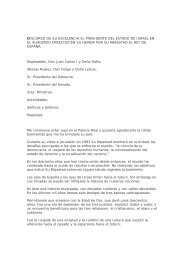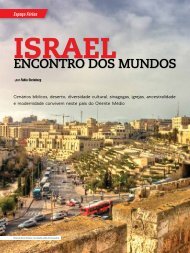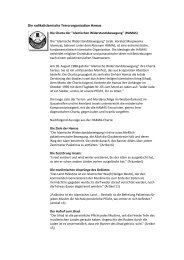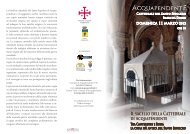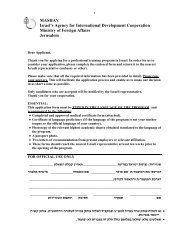Summary of the Verdict (TA 371/05) Estate of the Late Rachel Corrie ...
Summary of the Verdict (TA 371/05) Estate of the Late Rachel Corrie ...
Summary of the Verdict (TA 371/05) Estate of the Late Rachel Corrie ...
You also want an ePaper? Increase the reach of your titles
YUMPU automatically turns print PDFs into web optimized ePapers that Google loves.
(TRANSLATION)<br />
<strong>Summary</strong> <strong>of</strong> <strong>the</strong> <strong>Verdict</strong> (T.A. <strong>371</strong>/<strong>05</strong>) <strong>Estate</strong> <strong>of</strong> <strong>the</strong> <strong>Late</strong> <strong>Rachel</strong> <strong>Corrie</strong>, etc.<br />
v. The State <strong>of</strong> Israel – Ministry <strong>of</strong> Defense<br />
1. The decedent, <strong>Rachel</strong> <strong>Corrie</strong>, was born on April 10, 1979. She was an American<br />
citizen, residing in Olympia, Washington. On March 16, 2003, <strong>the</strong> decedent was<br />
killed during an incident which is <strong>the</strong> focus <strong>of</strong> this lawsuit. She was 24 years old.<br />
The decedent was an activist in <strong>the</strong> International Solidarity Movement (hereafter:<br />
"<strong>the</strong> Organization" or "<strong>the</strong> ISM").<br />
2. In this lawsuit (T.A. <strong>371</strong>/<strong>05</strong>) <strong>the</strong> plaintiffs, <strong>the</strong> estate <strong>of</strong> <strong>the</strong> late <strong>Rachel</strong> <strong>Corrie</strong><br />
(hereafter: "<strong>the</strong> decedent"), <strong>the</strong> decedent's parents, bro<strong>the</strong>r and sister, are petitioning<br />
to direct <strong>the</strong> defendant, <strong>the</strong> State <strong>of</strong> Israel, to pay <strong>the</strong>m compensation for special<br />
damages and general damages inflicted on <strong>the</strong>m, <strong>the</strong>y claim, as a result <strong>of</strong> <strong>the</strong> death<br />
<strong>of</strong> <strong>the</strong> decedent during <strong>the</strong> incident that is <strong>the</strong> focus <strong>of</strong> this trial. In addition to <strong>the</strong><br />
aforementioned, <strong>the</strong> plaintiffs have petitioned to direct <strong>the</strong> defendant to pay<br />
"punitive damages".<br />
3. The plaintiffs claimed in <strong>the</strong>ir lawsuit that on March 16, 2003, <strong>the</strong> decedent,<br />
toge<strong>the</strong>r with o<strong>the</strong>r activists in <strong>the</strong> ISM, arrived at <strong>the</strong> "Philadelphi Corridor" in <strong>the</strong><br />
Rafiah area <strong>of</strong> <strong>the</strong> Gaza Strip where two bulldozers and an IDF tank were observed<br />
conducting operational activities in <strong>the</strong> area. The plaintiffs claimed that <strong>the</strong><br />
bulldozers were about to demolish a house in <strong>the</strong> area and that <strong>the</strong> decedent and<br />
her fellow members <strong>of</strong> <strong>the</strong> ISM stood in <strong>the</strong> path <strong>of</strong> <strong>the</strong> bulldozers in order to prevent<br />
<strong>the</strong>m from implementing <strong>the</strong>ir plan.<br />
In Article 8.5 <strong>of</strong> <strong>the</strong> Statement <strong>of</strong> Claim, <strong>the</strong> plaintiffs claimed as follows:<br />
"At 17:00 or <strong>the</strong>reabouts, <strong>the</strong> decedent<br />
stood near <strong>the</strong> house <strong>of</strong> Dr. Samir<br />
Nasrallah, which was designated for<br />
demolition, and one <strong>of</strong> <strong>the</strong> bulldozers<br />
was 10 to 15 meters from her. The<br />
bulldozers approached <strong>the</strong> decedent<br />
and pulled dirt from under her feet. The<br />
decedent fell and <strong>the</strong> blade <strong>of</strong> <strong>the</strong><br />
bulldozer ran over her leg and later <strong>the</strong><br />
bulldozer ran over her body. When <strong>the</strong><br />
bulldozer backed up <strong>the</strong> decedent was<br />
gravely injured and was bleeding<br />
extensively, although she was still<br />
breathing.<br />
The decedent was evacuated to <strong>the</strong> Al-<br />
Najer Hospital in Rafiah, where her<br />
death was declared after 20 minutes".
4. The plaintiffs claimed that <strong>the</strong> bulldozer intentionally caused <strong>the</strong> death <strong>of</strong> <strong>the</strong><br />
decedent. The plaintiffs based <strong>the</strong>ir claim on <strong>the</strong> following three grounds: assault,<br />
negligence and legal grounds.<br />
5. After hearing many witnesses from both sides, including expert witnesses, and<br />
studying <strong>the</strong> extensive summations from representatives <strong>of</strong> both sides, I hereby<br />
determine as follows:<br />
a. During <strong>the</strong> relevant period <strong>of</strong> time, <strong>the</strong> "Philadelphi Corridor" was <strong>the</strong><br />
site <strong>of</strong> daily warfare, i.e. daily gunfire by snipers, missile fire and IED<br />
explosions directed at <strong>the</strong> IDF forces. During this period, unceasing efforts<br />
were made to kidnap IDF soldiers. Only soldiers who were in combat units<br />
fought in <strong>the</strong> region.<br />
According to <strong>the</strong> notes made in <strong>the</strong> IDF records, from September 2000 to<br />
<strong>the</strong> date <strong>of</strong> <strong>the</strong> incident that is <strong>the</strong> focus <strong>of</strong> this lawsuit (March 16, 2003),<br />
nearly 6,000 grenades had been thrown at IDF forces in <strong>the</strong> Corridor;<br />
<strong>the</strong>re had been approximately 1,400 incidents <strong>of</strong> gunfire; and <strong>the</strong>re were<br />
more than 40 occurrences <strong>of</strong> mortar fire. These aforementioned events<br />
led to <strong>the</strong> injury and death <strong>of</strong> many Israelis.<br />
The United States government issued a travel warning on March 16,<br />
2003 to warn American citizens against visiting <strong>the</strong> Gaza Strip area<br />
or <strong>the</strong> West Bank.<br />
b. During <strong>the</strong> period pertinent to this case, <strong>the</strong>re was a military directive in<br />
force declaring <strong>the</strong> "Philadelphi Corridor" a "closed military area" and<br />
forbidding <strong>the</strong> entry <strong>of</strong> civilians.<br />
c. The ISM assigned itself <strong>the</strong> task <strong>of</strong> working alongside <strong>the</strong> Palestinians<br />
against <strong>the</strong> "Israeli occupation" by using what it called "non-violent<br />
protest activities". However, <strong>the</strong> evidence presented to me shows a<br />
significant gap between <strong>the</strong> Organization's statements and <strong>the</strong> true<br />
character <strong>of</strong> its activities and actions. The actions taken by <strong>the</strong><br />
members <strong>of</strong> <strong>the</strong> organization, in practice, do not match its<br />
statements. In fact, <strong>the</strong> Organization exploits <strong>the</strong> dialogue regarding<br />
human rights and morality to blur <strong>the</strong> severity <strong>of</strong> its actions, which<br />
are, in fact, expressed through violence.<br />
Inter alia, ISM activities included "defending" Palestinian families, even<br />
ones that were engaged in terror activities. The Organization's activists<br />
"specialized" in sabotaging <strong>the</strong> IDF's operational actions. ISM<br />
activities included, inter alia: stationing activists to serve as "human<br />
shields" for terrorists wanted by Israeli security forces; financial, logistical<br />
and moral assistance to Palestinians, including terrorists and <strong>the</strong>ir families;<br />
interrupting demolition activities or <strong>the</strong> sealing <strong>of</strong>f <strong>of</strong> houses<br />
belonging to terrorists who conducted suicide attacks with multiple<br />
casualties.
d. The mission <strong>of</strong> <strong>the</strong> IDF force on <strong>the</strong> day <strong>of</strong> <strong>the</strong> incident was solely to<br />
clear <strong>the</strong> ground. This clearing and leveling included leveling <strong>the</strong> ground<br />
and clearing it <strong>of</strong> brush in order to expose hiding places used by terrorists,<br />
who would sneak out from <strong>the</strong>se areas and place explosive devices with<br />
<strong>the</strong> intent <strong>of</strong> harming IDF soldiers. There was an urgency to carrying out<br />
this mission so that IDF look-outs could observe <strong>the</strong> area and locate<br />
terrorists <strong>the</strong>reby preventing explosive devices from being buried. The<br />
mission did not include, in any way, <strong>the</strong> demolition <strong>of</strong> homes. The<br />
action conducted by <strong>the</strong> IDF forces was done at real risk to <strong>the</strong> lives <strong>of</strong> <strong>the</strong><br />
soldiers. Less than one hour before <strong>the</strong> incident that is <strong>the</strong> focus <strong>of</strong><br />
this lawsuit, a live hand-grenade was thrown at <strong>the</strong> IDF forces.<br />
e. I hereby determine that, on <strong>the</strong> day <strong>of</strong> <strong>the</strong> incident, <strong>the</strong> two bulldozers and<br />
<strong>the</strong> armored personnel carrier were occupied with <strong>the</strong> clear military<br />
operational task <strong>of</strong> clearing <strong>the</strong> land in a dangerous area which<br />
posed a significant risk. The force's action was designed to prevent<br />
acts <strong>of</strong> terror and hostility, i.e. to eliminate <strong>the</strong> danger <strong>of</strong> terrorists<br />
hiding between <strong>the</strong> creases <strong>of</strong> land and in <strong>the</strong> brush, and to expose<br />
explosive devices hidden <strong>the</strong>rein, both <strong>of</strong> which were intended to kill<br />
IDF soldiers. During each act <strong>of</strong> exposure, <strong>the</strong> lives <strong>of</strong> <strong>the</strong> IDF fighters<br />
were at risk from Palestinians terrorists. As aforementioned, less than an<br />
hour before <strong>the</strong> incident that is <strong>the</strong> focus <strong>of</strong> this lawsuit, a live handgrenade<br />
was thrown at <strong>the</strong> IDF force.<br />
For this reason, I hereby determine that <strong>the</strong> act <strong>of</strong> clearing <strong>the</strong> land with<br />
which <strong>the</strong> IDF force was occupied during <strong>the</strong> event was "a war-related<br />
action" as defined in The Civil Wrongs Ordinance.<br />
f. On March 16, 2003, <strong>the</strong> decedent and her fellow ISM activists arrived at<br />
<strong>the</strong> location where <strong>the</strong> IDF force was working to clear <strong>the</strong> land. They did<br />
so, <strong>the</strong>y claim, in order to prevent <strong>the</strong> IDF force from demolishing<br />
Palestinian houses. They did so illegally and in contradiction <strong>of</strong> <strong>the</strong> military<br />
directive declaring <strong>the</strong> area a "closed military area". They held signs,<br />
stood in front <strong>of</strong> <strong>the</strong> bulldozers and did not allow <strong>the</strong>m to carry out <strong>the</strong>ir<br />
mission. The IDF soldiers informed <strong>the</strong> activists that <strong>the</strong>y had to distance<br />
<strong>the</strong>mselves from <strong>the</strong> area, threw stun grenades towards <strong>the</strong>m, fired<br />
warning shots towards <strong>the</strong>m and used methods to disperse<br />
demonstrations. All without avail.<br />
The IDF force was very careful not to harm <strong>the</strong> Organization's activists.<br />
Because <strong>of</strong> <strong>the</strong> activists' interference, <strong>the</strong> force repeatedly relocated to<br />
continue carrying out <strong>the</strong>ir mission.<br />
g. Based on <strong>the</strong> evidence presented to me, including <strong>the</strong> testimony <strong>of</strong> <strong>the</strong><br />
expert for <strong>the</strong> prosecution, Mr. Osben, I hereby determine that at<br />
approximately 17:00, <strong>the</strong> decedent stood roughly 15 to 20 meters from <strong>the</strong><br />
relevant bulldozer and knelt down. The bulldozer to which I refer was a<br />
large, clumsy and shielded vehicle <strong>of</strong> <strong>the</strong> DR9 model. The field <strong>of</strong> view <strong>the</strong>
ulldozer's operator had inside <strong>the</strong> bulldozer was limited. At a certain<br />
point, <strong>the</strong> bulldozer turned and moved toward <strong>the</strong> decedent. The bulldozer<br />
pushed a tall pile <strong>of</strong> dirt. With regard to <strong>the</strong> field <strong>of</strong> view that <strong>the</strong><br />
bulldozer's operator had, <strong>the</strong> decedent was in <strong>the</strong> "blind spot". The<br />
decedent was behind <strong>the</strong> bulldozer's blade and behind a pile <strong>of</strong> dirt and<br />
<strong>the</strong>refore <strong>the</strong> bulldozer's operator could not have seen her.<br />
The bulldozer moved very slowly, at a speed <strong>of</strong> one kilometer per hour.<br />
decedent saw <strong>the</strong> pile <strong>of</strong> dirt moving towards her, she did not move, as<br />
any reasonable person would have. She began to climb <strong>the</strong> pile <strong>of</strong> dirt.<br />
Therefore, both because <strong>the</strong> pile <strong>of</strong> dirt continued to move as a result <strong>of</strong><br />
<strong>the</strong> pushing <strong>of</strong> <strong>the</strong> bulldozer, and because <strong>the</strong> dirt was loose, <strong>the</strong><br />
decedent was trapped in <strong>the</strong> pile <strong>of</strong> dirt and fell.<br />
At this stage, <strong>the</strong> decedent's legs were buried in <strong>the</strong> pile <strong>of</strong> dirt, and when<br />
her colleagues saw from where <strong>the</strong>y stood that <strong>the</strong> decedent was trapped<br />
in <strong>the</strong> pile <strong>of</strong> dirt, <strong>the</strong>y ran towards <strong>the</strong> bulldozer and gestured towards its<br />
operator and yelled at him to stop. By <strong>the</strong> time <strong>the</strong> bulldozer's operator<br />
and his commander noticed <strong>the</strong> decedent's colleagues and stopped <strong>the</strong><br />
bulldozer, a significant portion <strong>of</strong> <strong>the</strong> decedent's body was already<br />
covered in dirt.<br />
The decedent's entire body was not covered in dirt. In fact, when <strong>the</strong><br />
bulldozer backed up, <strong>the</strong> decedent's body was seen to free herself from<br />
<strong>the</strong> pile <strong>of</strong> dirt and <strong>the</strong> decedent was still alive.<br />
The decedent was evacuated to <strong>the</strong> hospital and after 20 minutes, her<br />
death was declared.<br />
I hereby determine unequivocally that <strong>the</strong>re is no foundation to <strong>the</strong><br />
plaintiffs' claim that <strong>the</strong> bulldozer struck <strong>the</strong> decedent intentionally.<br />
This was a very unfortunate accident and was not intentional. No one<br />
wished to harm <strong>the</strong> decedent. I was convinced that <strong>the</strong> bulldozer's<br />
operator would not have continued to work if he had seen <strong>the</strong> decedent<br />
standing in front <strong>of</strong> <strong>the</strong> bulldozer, as he and his colleagues acted in similar<br />
circumstances earlier that day, when <strong>the</strong>y moved from location to location<br />
because <strong>of</strong> <strong>the</strong> disturbances caused by <strong>the</strong> members <strong>of</strong> <strong>the</strong> Organization.<br />
Because I find, as aforementioned, that <strong>the</strong> decedent was accidentally<br />
killed in <strong>the</strong> framework <strong>of</strong> a "war-related activity" as defined in The Civil<br />
Wrongs Ordinance, and in light <strong>of</strong> <strong>the</strong> instructions laid out in Article 5 <strong>of</strong><br />
<strong>the</strong> aforementioned ordinance, <strong>the</strong> State bears no responsibility for <strong>the</strong><br />
damages inflicted on <strong>the</strong> plaintiffs resulting from a war-related action.<br />
This makes superfluous <strong>the</strong> need to discuss <strong>the</strong> cause <strong>of</strong> action made by<br />
<strong>the</strong> plaintiffs because legally <strong>the</strong>ir demand should be rejected.<br />
Never<strong>the</strong>less, above and beyond what is necessary, I have also decided<br />
to discuss <strong>the</strong> cause <strong>of</strong> action filed by <strong>the</strong> plaintiffs as well as <strong>the</strong>ir o<strong>the</strong>r<br />
claims.
h. The plaintiffs claimed that evidentiary damage was done in two areas:<br />
first, <strong>the</strong>y claim that <strong>the</strong> Criminal Investigations Division (CID)<br />
investigation carried out after <strong>the</strong> event was sloppy and unpr<strong>of</strong>essional<br />
and led to evidentiary damage for <strong>the</strong> plaintiffs; <strong>the</strong> second area, which<br />
refers to <strong>the</strong> responsibility <strong>of</strong> <strong>the</strong> Institute for Forensic Medicine for<br />
evidentiary damage caused to <strong>the</strong> plaintiffs as a result <strong>of</strong> <strong>the</strong> violation <strong>of</strong><br />
<strong>the</strong> judicial order and <strong>the</strong> destruction <strong>of</strong> <strong>the</strong> recording documenting <strong>the</strong><br />
decedent's autopsy.<br />
It could be expected that, in light <strong>of</strong> <strong>the</strong> claim made above, <strong>the</strong> plaintiffs'<br />
representative would submit to <strong>the</strong> court <strong>the</strong> file <strong>of</strong> <strong>the</strong> investigation<br />
conducted by <strong>the</strong> CID so that I could form my own opinion regarding <strong>the</strong><br />
investigatory actions carried out and <strong>the</strong> manner in which <strong>the</strong> investigation<br />
was carried out, and to learn if <strong>the</strong> actions taken by <strong>the</strong> CID were<br />
sufficient or not. However, it was <strong>the</strong> plaintiffs that objected to submitting<br />
<strong>the</strong> full file <strong>of</strong> <strong>the</strong> investigation as evidence, even though <strong>the</strong> defendant<br />
agreed to do so. Thus did <strong>the</strong> plaintiffs, by <strong>the</strong>ir own actions, introduce<br />
circumstances in which an extremely important tool to examine <strong>the</strong>ir<br />
claims was denied to <strong>the</strong> court.<br />
After examining <strong>the</strong> evidentiary material and studying <strong>the</strong> claims made by<br />
representatives <strong>of</strong> both sides, I reached <strong>the</strong> conclusion that <strong>the</strong> CID<br />
investigation was conducted appropriately and without fault.<br />
i. With regard to <strong>the</strong> claims made regarding evidentiary damages relating to<br />
<strong>the</strong> Institute <strong>of</strong> Forensic Medicine:<br />
Investigators from <strong>the</strong> CID concluded that in order to advance <strong>the</strong><br />
investigation, an autopsy would have to be performed on <strong>the</strong> decedent. As<br />
a result, <strong>the</strong>y approached <strong>the</strong> District Court in Rishon LeZion and asked<br />
for a court order that would allow for such an autopsy. The court order<br />
"…that <strong>the</strong> body be autopsied at <strong>the</strong> Abu Kabir Institute for Forensic<br />
Medicine by a doctor who is not in <strong>the</strong> military and in <strong>the</strong> presence <strong>of</strong><br />
a representative <strong>of</strong> <strong>the</strong> American State Department" (Exhibit 6/T).<br />
Pr<strong>of</strong>essor Hiss testified that since <strong>the</strong> American Consulate saw no need to<br />
send a representative to be present at <strong>the</strong> autopsy, <strong>the</strong> autopsy was<br />
conducted, with <strong>the</strong> family's agreement, without a consular<br />
representative. He also testified that <strong>the</strong> Consulate sent a fax confirming<br />
that <strong>the</strong> autopsy could be conducted without a representative from <strong>the</strong><br />
family (Exhibit 11/T).<br />
After examining <strong>the</strong> evidentiary material and studying <strong>the</strong> claims made by<br />
representatives <strong>of</strong> both sides, I reached <strong>the</strong> conclusion that <strong>the</strong> plaintiffs'<br />
claim <strong>of</strong> evidentiary damage by <strong>the</strong> Institute for Forensic Medicine<br />
seems strange. This is because <strong>the</strong> decedent's fa<strong>the</strong>r himself testified that,<br />
from <strong>the</strong> outset, <strong>the</strong> family had no intention <strong>of</strong> conducting an autopsy and<br />
that <strong>the</strong>ir intention was to pursue <strong>the</strong> matter diplomatically in order to<br />
clarify what happened to <strong>the</strong> decedent. Moreover: it appears that <strong>the</strong>
decedent's family had no interest regarding <strong>the</strong> identity <strong>of</strong> <strong>the</strong> Consular<br />
representative that was to be present during <strong>the</strong> autopsy, nor in <strong>the</strong> type<br />
<strong>of</strong> pr<strong>of</strong>essional training <strong>the</strong>y had had. The family wanted a Consular<br />
representative to be present even if a secretary or typist had been sent!<br />
Pr<strong>of</strong>essor Hiss explained in his testimony that <strong>the</strong> aforementioned fax was<br />
sent to him after he telephoned <strong>the</strong> United States Embassy and asked<br />
that <strong>the</strong>y send an American doctor to be present at <strong>the</strong> autopsy. He<br />
claims that <strong>the</strong> embassy did not find a need to do so. Pr<strong>of</strong>essor Hiss<br />
asked to receive approval from <strong>the</strong> decedent's family and he <strong>the</strong>n<br />
received <strong>the</strong> fax 11/T in which it is specifically stated that <strong>the</strong> decedent's<br />
family agreed to <strong>the</strong> autopsy and that no o<strong>the</strong>r faxes would be sent.<br />
I believe that under <strong>the</strong>se circumstances, Pr<strong>of</strong>essor Hiss was well within<br />
his rights to conclude that, ultimately, <strong>the</strong> decedent's family conceded its<br />
demand for a representative to be present during <strong>the</strong> autopsy. The<br />
family's desire was to receive <strong>the</strong> decedent's body as soon as possible.<br />
Indeed, <strong>the</strong> family did not conduct any additional examinations after<br />
receiving <strong>the</strong> decedent's body and it was cremated: see Mr. Craig <strong>Corrie</strong>'s<br />
testimony.<br />
I am aware <strong>of</strong> <strong>the</strong> fact that, according to <strong>the</strong> language <strong>of</strong> <strong>the</strong> District<br />
Court's decision regarding <strong>the</strong> autopsy <strong>of</strong> <strong>the</strong> decedent's body, <strong>the</strong>re<br />
should have been a representative <strong>of</strong> <strong>the</strong> US Embassy present during <strong>the</strong><br />
autopsy. However, under <strong>the</strong> circumstances, when it was explained that<br />
<strong>the</strong> embassy saw no reason to send a representative, as Pr<strong>of</strong>essor Hiss<br />
testified, and because <strong>the</strong> fax sent to Pr<strong>of</strong>essor Hiss (11/T) stated that <strong>the</strong><br />
family agreed to <strong>the</strong> autopsy, we can understand why Pr<strong>of</strong>essor Hiss<br />
believed that <strong>the</strong>re was nothing preventing him from conducting <strong>the</strong><br />
autopsy without an embassy representative being present. There is no<br />
doubt that <strong>the</strong> proper course <strong>of</strong> action would have been to return to<br />
<strong>the</strong> District Court so that, in light <strong>of</strong> <strong>the</strong> change in circumstances, <strong>the</strong><br />
court could amend its decision and remove <strong>the</strong> condition regarding<br />
<strong>the</strong> presence <strong>of</strong> an embassy representative. However, given <strong>the</strong><br />
circumstances and in light <strong>of</strong> <strong>the</strong> aforementioned, it is not clear what<br />
evidentiary damage was made to <strong>the</strong> plaintiffs' case because <strong>of</strong> <strong>the</strong><br />
conduct <strong>of</strong> <strong>the</strong> Institute <strong>of</strong> Forensic Medicine.<br />
With regard to <strong>the</strong> plaintiffs' claim regarding <strong>the</strong> recording documenting<br />
<strong>the</strong> autopsy, I found no grounds to accept it. It is an audio recording (as<br />
opposed to a video recording) which served as a draft for Pr<strong>of</strong>essor<br />
Hiss when preparing his report. Recordings like this are made because,<br />
during an autopsy, <strong>the</strong> doctor's hands are holding scalpels and covered in<br />
blood, and <strong>the</strong>refore notes cannot be taken. Apparently, <strong>the</strong><br />
aforementioned audio recording simply does not exist anymore because,<br />
due to budgetary problems, <strong>the</strong> Institute <strong>of</strong> Forensic Medicine<br />
recycles tapes (see <strong>the</strong> testimony given by Pr<strong>of</strong>essor Hiss). Under<br />
<strong>the</strong>se circumstances, it is not clear what evidentiary damage was caused
to <strong>the</strong> plaintiffs as a result <strong>of</strong> <strong>the</strong> aforementioned draft having been erased<br />
due to recycling.<br />
In summation, with regard to evidentiary damages, I hereby<br />
determine that <strong>the</strong> two cumulative conditions necessary as laid out<br />
in <strong>the</strong> precedent determined by <strong>the</strong> Supreme Court were not upheld.<br />
They did not prove that evidentiary damage was caused which<br />
harmed <strong>the</strong>ir ability to prove <strong>the</strong>ir claims, nor did <strong>the</strong>y prove that <strong>the</strong><br />
defendant, through negligence, caused <strong>the</strong> claimed evidentiary<br />
damage.<br />
j. With regard to grounds for assault I hereby determine that <strong>the</strong>re is no<br />
foundation for such claims because <strong>the</strong>re is no component <strong>of</strong> "malice". As<br />
I have determined that <strong>the</strong> decedent was killed accidentally and not<br />
intentionally, legally <strong>the</strong> claim regarding grounds for assault must be<br />
rejected.<br />
k. With regard to grounds for negligence: I am convinced that, given <strong>the</strong><br />
circumstances created at <strong>the</strong> location <strong>of</strong> <strong>the</strong> incident, <strong>the</strong> actions taken by<br />
<strong>the</strong> force were without fault. Indeed, <strong>the</strong> field <strong>of</strong> vision <strong>of</strong> <strong>the</strong> bulldozer's<br />
operator was limited. However, <strong>the</strong> decedent's field <strong>of</strong> vision while she<br />
stood in front <strong>of</strong> <strong>the</strong> bulldozer and knelt down was open and without any<br />
limitation. The decedent could have distanced herself from any danger<br />
without any difficulty. However, she chose to take <strong>the</strong> risk described<br />
above, and that eventually led to her death.<br />
Given <strong>the</strong>se circumstances, I have reached <strong>the</strong> conclusion that it was not<br />
negligence on <strong>the</strong> part <strong>of</strong> <strong>the</strong> defendant or any <strong>of</strong> its representatives that<br />
caused <strong>the</strong> decedent's death. Therefore it can be understood that I reject<br />
<strong>the</strong> claim that <strong>the</strong>re is any foundation for <strong>the</strong> grounds <strong>of</strong> negligence in this<br />
case.<br />
The defendant claims a "willing endangerment" defense, in<br />
accordance with Article 5(A) <strong>of</strong> <strong>the</strong> Civil Wrongs ordinance. I reached<br />
<strong>the</strong> conclusion that <strong>the</strong> foundation for this defense, as determined by <strong>the</strong><br />
Supreme Court, has not been proven in this case, and <strong>the</strong>refore I hereby<br />
determine that <strong>the</strong> aforementioned defense does not exist with regard to<br />
this lawsuit.<br />
However, even though I have determined that it was not negligence on<br />
<strong>the</strong> part <strong>of</strong> <strong>the</strong> defendant or its representatives that led to <strong>the</strong> death <strong>of</strong> <strong>the</strong><br />
decedent, and although <strong>the</strong> aforementioned defense does not exist with<br />
regard to this lawsuit, it is not enough to change <strong>the</strong> result <strong>of</strong> rejecting this<br />
claim.<br />
l. With regard to legal grounds: It is true that <strong>the</strong> decedent was killed<br />
during <strong>the</strong> incident that is <strong>the</strong> focus <strong>of</strong> this lawsuit. However, in this case<br />
<strong>the</strong> defendant did not violate <strong>the</strong> decedent's right to life. The<br />
decedent put herself in a dangerous situation. She stood in front <strong>of</strong> a large
ulldozer in a location where <strong>the</strong> bulldozer's operator could not see her.<br />
Even when she saw <strong>the</strong> pile <strong>of</strong> dirt moving towards her and endangering<br />
her, she did not remove herself from <strong>the</strong> situation, as any reasonable<br />
person would have. The decedent began to climb <strong>the</strong> pile <strong>of</strong> dirt, got<br />
tangled up in it, fell and eventually died.<br />
The decedent's death was <strong>the</strong> result <strong>of</strong> an accident that <strong>the</strong> decedent<br />
caused. This occurred despite <strong>the</strong> efforts <strong>of</strong> <strong>the</strong> IDF force to distance her<br />
and her colleagues from <strong>the</strong> area.<br />
I believe that, under <strong>the</strong>se circumstances, <strong>the</strong>re is no justification to<br />
obligate <strong>the</strong> State to pay compensation for damages that <strong>the</strong> decedent<br />
could have prevented, but preferred not to, <strong>the</strong>reby choosing to risk her<br />
life as she did.<br />
Therefore, I reject <strong>the</strong> request to obligate <strong>the</strong> State to pay compensation<br />
on legal grounds.<br />
6. Because <strong>of</strong> this and in light <strong>of</strong> <strong>the</strong> aforementioned, I reject <strong>the</strong> lawsuit.<br />
Because <strong>of</strong> <strong>the</strong> circumstance surrounding <strong>the</strong> decedent's death, I will not make<br />
<strong>the</strong> plaintiffs' pay <strong>the</strong> legal expenses and each side will bear its own costs.




